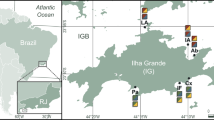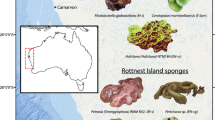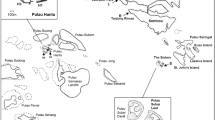Abstract
During a multi-agency Australian Government initiative sponges were sampled at three areas from Carnarvon Shelf, NW Australia. Sponges were identified to lowest possible level, largely as morphospecies (84%). A searchable and interactive taxonomic catalogue was created and is publicly accessible through the Ningaloo Atlas collated by the Australian Institute for Marine Science. The sponge gardens on Carnarvon Shelf are patchily distributed but highly diverse and occasionally extremely dense. We examined 754 specimens and distinguished 261 species belonging to 112 genera. Species accumulation curves indicate that this species number does not represent local sponge biodiversity, which is projected to reach up to 840 species with additional sampling. Many observed species appear to be new to science, 81% occurred only at one of the three areas, about 56% were singletons, and 76% had a wet weight of ≤500 g. Detailed spatial analyses were difficult due to sampling design, but general trends could be detected. The northern areas, where the Australian continental shelf is narrowest, favour sponges with a higher content of inorganic skeleton and growth forms able to withstand the strong tidal currents and exposure typical for this area. Sponges were most abundant at the shelf edge, where massive forms dominated. While the central and northern areas are protected by zoning regulations, the southern area had the highest species diversity, the largest individuals and the densest distributions, suggesting additional conservation measures may be required. Western Australia is clearly an important, but under-studied bioregion for sponges, and future research foci are proposed.








Similar content being viewed by others
References
11th International Coral Reef Symposium. Fort Lauderdale, Florida, USA, July 7–11, 2008. Available at http://www.nova.edu/ncri/11icrs/index.html. Accessed 12/10/2010.
8th World Sponge Conference, 2010. Ancient Animals, New Challenges. Available at http://www.spongeconference2010.org/. Accessed 12/10/2010.
Aperio, 2010. SCAN—High-Quality, Ultra-Resolution Digital Scanning. Available at http://www.aperio.com/pathology-services/scanscope-digital-scanners.asp. Accessed 12/10/2010.
Australian Broadcasting Corporation, 1998. Jewels of the Sea. Sponge Gardens. Available at http://www.abc.net.au/oceans/jewel/sponge/default.htm. Accessed 12/10/2010.
Australian Government, 2011. Department of Sustainability, Environment, Water, Population and Communities, Ningaloo Coast. Available at http://www.environment.gov.au/heritage/places/world/ningaloo/index.html. Accessed 27/6/2011.
Bax, N. J., B. Brooke, D. Gledhill, R. Pitcher & C. Wilcox, 2011. CERF Marine Biodiversity Hub Final Report 2007–2010. CERF Marine Biodiversity Hub, Hobart: 76 pp. Available at http://www.marinehub.org/cerf-marine-biodiversity-hub-final-report-2007-2010. Accessed 22/6/2011.
Becerro, M. A., 2008. Quantitative trends in sponge ecology research. Marine Ecology 29: 167–177.
Brooke, B., S. Nichol, M. Hughes, M. McArthur, T. Anderson, R. Przeslawski, J. Siwabessy, A. Heyward, C. Battershill, J. Colquhoun & P. Doherty (eds), 2009. Carnarvon Shelf Survey. Post Survey Report August 12th–September 15th, 2008. Geoscience Australia Record 2009/02: 89 pp.
Centre for Microscopy, Characterisation and Analysis, 2010. Aperio Scanscope Digital Slide Scanner. Available at http://www.cmca.uwa.edu.au/facilities/ocm/aperio-scanscope. Accessed 12/10/2010.
Chu, J. W. F. & S. L. Leys, 2010. High resolution mapping of community structure in three glass sponge reefs (Porifera, Hexactinellida). Marine Ecology Progress Series 417: 97–113.
Coleman, N. & N. Marsh, 2003. Diving Australia. A Guide to the Best Diving Down Under. Tuttle Publishing, Sydney.
Colquhoun, J. & A. Heyward (eds), 2008. Ningaloo Reef Marine Park Deepwater Benthic Biodiversity Survey. Annual Report 2007. Joint Report by the Australian Institute of Marine Science, Curtin University of Technology, The University of Western Australia and the Western Australian Museum. Perth: 195 pp.
Colwell, R. K., 2005. EstimateS: Statistical Estimation of Species Richness and Shared Species from Samples. Version 7.5. User’s Guide and Application Published at: http://purl.oclc.org/estimates. Accessed 29/11/2010.
Colwell, R. K. & J. A. Coddington, 1994. Estimating terrestrial biodiversity through extrapolation. Philosophical Transactions of the Royal Society B 345: 101–118.
Coral-List, 2010. NOAA’s Coral Health and Monitoring Program (CHAMP) Listserver for Coral Reef Information and News. Available at http://coral.aoml.noaa.gov/mailman/listinfo/coral-list/. Accessed 12/10/2010.
Daly, M., M. R. Brugler, P. Cartwright, A. G. Collins, M. N. Dawson, D. G. Fautin, S. C. France, C. S. McFadden, D. M. Opresko, E. Rodriguez, S. L. Romano & J. L. Stake, 2007. The Phylum Cnidaria: a review of phylogenetic patterns and diversity 300 years after Linnaeus. Zootaxa 1668: 127–182.
de Voogd, N. J. & D. F. R. Cleary, 2008. An analysis of sponge diversity and distribution at three taxonomic levels in the Thousand Islands/Jakarta Bay reef complex, West-Java, Indonesia. Marine Ecology 29: 205–215.
de Voogd, N. J., D. F. R. Cleary, B. W. Hoeksema, A. Noor & R. W. M. van Soest, 2006. Sponge beta diversity at the Spermonde Archipelago, SW Sulawesi, Indonesia. Marine Ecology Progress Series 309: 131–142.
de Voogd, N. J., L. E. Becking & D. F. R. Cleary, 2009. Sponge community composition in the Derawan Islands, NE Kalimantan, Indonesia. Marine Ecology Progress Series 396: 169–180.
Diaz, M. C. & K. Rützler, 2001. Sponges: an essential component of Caribbean coral reefs. Bulletin of Marine Science 69: 535–546.
Fromont, J., 1999. The demosponge fauna of the Houtman Abrolhos Islands. Memoirs of the Queensland Museum 44: 175–183.
Fromont, J., 2004. Porifera (sponges) of the Dampier Archipelago, Western Australia: habitats and distribution. In Jones, D. S. (ed.), Aquatic Fauna of the Waters of the Dampier Archipelago, Western Australia. Report of the Woodside Energy Ltd/Western Australia Museum Partnership to Explore the Marine Biodiversity of the Dampier Archipelago, 1998–2001. Records of the Western Australian Museum Supplement 66: 69–100.
Fromont, J. & M. A. Vanderklift, 2009. Porifera (sponges) of Mermaid reef (Rowley Shoals), Scott and Seringapatam Reefs, Western Australia. Records of the Western Australian Museum Supplement 77: 81–104.
Fromont, J., M. A. Vanderklift & G. A. Kendrick, 2006. Marine sponges of the Dampier Archipelago, Western Australia: patterns of species distributions, abundance and diversity. Biodiversity and Conservation 15: 3731–3750.
Geoscience Australia, 2010. Marine Biodiversity Hub. Available at http://www.marinehub.org/index.php/site/home. Accessed 1/7/2011.
Heyward, A., J. Fromont, C. H. L. Schönberg, J. Colquhoun, B. Radford & O. Gomez, 2010. The sponge gardens of Ningaloo Reef, Western Australia. Open Marine Biology Journal 4: 3–11.
Hooper, J. N. A., 1988. Structural features of the benthic community of East Point Reef Fish Reserve. A comparative study between oceanic, near-shore and inshore reefs of northwest Australia. In Larson, H. K., M. G. Michie & J. R. Hanley (eds), Darwin Harbour. Australian National University North Australian Research Unit Mangrove Monograph 4. North Australian Research Unit, ANU, Darwin: 214–225.
Hooper, J. N. A., 1994. Coral reef sponges of the Sahul Shelf—a case for habitat preservation. Memoirs of the Queensland Museum 36: 93–106.
Hooper, J. N. A. & M. Ekins, 2004 (published online 2009). Collation and Validation of Museum Collection Databases Related to the Distribution of Marine Sponges in Northern Australia. Report to the National Oceans Office Contract C2004/020 and Technical Reports of the Queensland Museum 002: 1-224. Available at http://www.environment.gov.au/coasts/mbp/publications/general/nmb-sponge-report.html and http://www.qm.qld.gov.au/Research/Publications/Publications/Technical+reports/002+Collation+and+validation+of+museum+collection+databases. Accessed 22/6/2011.
Hooper, J. N. A. & J. A. Kennedy, 2002. Small-scale patterns of sponge biodiversity (Porifera) on Sunshine Coast reefs, eastern Australia. Invertebrate Systematics 16: 637–653.
Hooper, J. N. A., J. A. Kennedy & R. W. M. van Soest, 2000. An annotated checklist of sponges (Porifera) of the South China Sea Region. The Raffles Bulletin of Zoology 8: 125–207.
Hooper, J. N. A. & M. A. Schlacher-Schoenlinger, 2007. Porifera of New Caledonia. Remarks on the check list of shallow water species. In Payri, C. E. & D. Richer De Forges (eds), Compendium of marine species from New Caledonia, Special Volume II(7), 2nd edn. Institut de Recherche pour le Developpement. Documents Scientifiques et Techniques of IRD Centre de Noumea: 113–117.
Hooper, J. N. A., J. A. Kennedy & R. J. Quinn, 2002. Biodiversity ‘hotspots’, patterns of richness and endemism, and taxonomic affinities of tropical Australian sponges (Porifera). Biodiversity and Conservation 11: 851–885.
Kostylev, V. E., B. J. Todd, G. B. J. Fader, R. C. Courtney, G. D. M. Cameron & R. A. Pickrill, 2001. Benthic habitat mapping on the Scotian Shelf based on multibeam bathymetry, surficial geology and sea floor photographs. Marine Ecology Progress Series 219: 121–137.
McClintock, J. B., C. D. Amsler, B. J. Baker & R. W. M. van Soest, 2005. Ecology of Antarctic marine sponges: an overview. Integrative and Comparative Biology 45: 359–368.
Porifera-List, 2010. Jiscm@il Porifera homepage. Available at https://www.jiscmail.ac.uk/cgi-bin/webadmin?A0=porifera. Accessed 12/10/2010.
Reef Watch Victoria, 2006. Take a Dive that Counts. Sponge Gardens. Available at http://www.reefwatchvic.asn.au/MarineLife/Habitats/3_SpongeHabitats.htm. Accessed 12/10/2010.
Samaai, T., 2006. Biodiversity ‘hotspots’, patterns of richness and endemism, and distribution of marine sponges in South Africa based on actual and interpolation data: a comparative approach. Zootaxa 1358: 1–37.
Samaai, T., M. J. Gibbons, S. Kerwath, D. Yemane & K. Sink, 2010. Sponge richness along a bathymetric gradient within the iSimangaliso Wetland Park, South Africa. Marine Biodiversity 40: 205–217.
Schlacher, T. A., M. A. Schlacher-Hoenlinger, A. Williams, F. Althaus, J. N. A. Hooper & R. Kloser, 2007. Richness and distribution of sponge megabenthos in continental margin canyons off southeastern Australia. Marine Ecology Progress Series 340: 73–88.
Schönberg, C. H. L., J. Fromont, B. Alvarez, C. Battershill, A. Pisera, P. Sutcliffe, S. Sorokin, L. Goudie, O. Gomez & M. Case, 2011. The Ningaloo sponge catalogue. As part of: B. Radford & T. Ridgway (eds.) The Ningaloo Atlas. Available at http://ningaloo-atlas.org.au/. Accessed 30/8/2011.
Sorokin, S., J. Fromont & D. Currie, 2007. Demosponge biodiversity in the Great Australian Bight’s benthic protection zone. Transactions of the Royal Society of South Australia 131: 192–204.
State of New South Wales, 2005. Primary Industries Fisheries and Aquaculture. Marine Habitats. Available at http://www.dpi.nsw.gov.au/fisheries/habitat/aquatic-habitats/marine. Accessed 12/10/2010.
Sutcliffe, P. R., J. N. A. Hooper & C. R. Pitcher, 2010. The most common sponges on the Great Barrier Reef seabed, Australia, include species new to science (Phylum Porifera). Zootaxa 2616: 1–30.
Thomson Reuter’s (ISI) Web of Knowledge. Citation and Journal Database for Academic Users. Available at http://apps.isiknowledge.com/UA_GeneralSearch_input.do?product=UA&search_mode=GeneralSearch&SID=X2pFj1294BKAEN82Ph3&preferencesSaved=. Accessed through the Australian Institute of Marine Sciences information services 24/6/2011.
van Soest, R. W. M, N. Boury-Esnault, J. N. A. Hooper, K. Rützler, N. J. de Voogd, B. Alvarez de Glasby, E. Hajdu, A. B. Pisera, R. Manconi, C. H. L. Schönberg, D. Janussen, K. R. Tabachnick, M. Klautau, B. Picton & M. Kelly, 2011. World Porifera Database. Available at http://www.marinespecies.org/porifera. Accessed 22/6/2011.
Wörheide, G., A. M. Solé-Cava & J. N. A. Hooper, 2005. Biodiversity, molecular ecology and phylogeography of marine sponges: patterns, implications and outlooks. Integrative and Comparative Biology 45: 377–385.
Zoological Record, 2011. The World’s Oldest Continuing Database of Animal Biology. Available at http://thomsonreuters.com/products_services/science/science_products/a-z/zoological_record/. Accessed through the University of Western Australia information services 24/6/2011.
Acknowledgments
The present results are the product of input by many people. Fieldwork was conducted in collaboration between AIMS, Geoscience Australia and WAM on board the RV Solander. During the cruise, sponges were processed by C. Battershill, J. Colquhoun, O. Gomez, A. Heyward, M. McArthur, R. Przeslawski and C. Wolff. E. Willen taught CS how to make wax–glycerol preparations. Help in the laboratory was provided by part time assistants S. Tecchiato, S. Yaqub, L. Roger and R. Ninio. We appreciate all the good assistance received at CMCA at UWA: P. Clode, D. Crisan, L. Kirilak, J. Murphy, S. Parry, P. Rigby and A. Suvorova. Participants of the February 2010 sponge taxonomy workshop in Perth deserve special thanks for finalising and correcting preliminary sponge identifications during 5 days of very intensive work: B. Alvarez (Glasby), C. Battershill, O. Gomez, L. Goudie, A. Pisera, S. Sorokin and P. Sutcliffe. Additional taxonomic advice was received via e-mail from P. Cardenas, E. Hajdu, J. Hooper, R. van Soest and J. Vacelet. M. Case at AIMS created the portfolio on the descriptive sponge data which is now available as the CERF Sponge Catalogue, B. Radford provided the map in Fig. 1, and the Ningaloo Atlas was implemented by him and T. Ridgway. R. Fisher initiated CS into the skills of biodiversity analyses. This work has been partly funded through the CERF program, an Australian Government initiative. The CERF Marine Biodiversity Hub is a collaborative partnership between the University of Tasmania, CSIRO Wealth from Oceans Flagship, Geoscience Australia, Australian Institute of Marine Science and Museum Victoria.
Author information
Authors and Affiliations
Corresponding author
Additional information
Guest editors: M. Maldonado, X. Turon, M. A. Becerro & M. J. Uriz / Ancient animals, new challenges: developments in sponge research
Electronic supplementary material
Below is the link to the electronic supplementary material.
Rights and permissions
About this article
Cite this article
Schönberg, C.H.L., Fromont, J. Sponge gardens of Ningaloo Reef (Carnarvon Shelf, Western Australia) are biodiversity hotspots. Hydrobiologia 687, 143–161 (2012). https://doi.org/10.1007/s10750-011-0863-5
Received:
Accepted:
Published:
Issue Date:
DOI: https://doi.org/10.1007/s10750-011-0863-5




